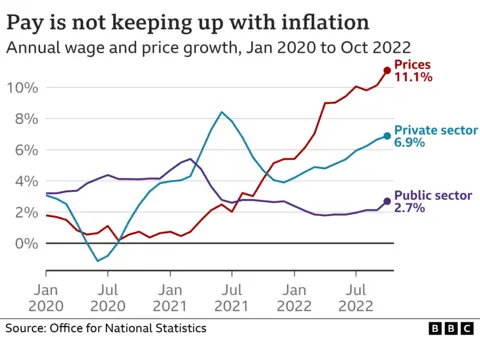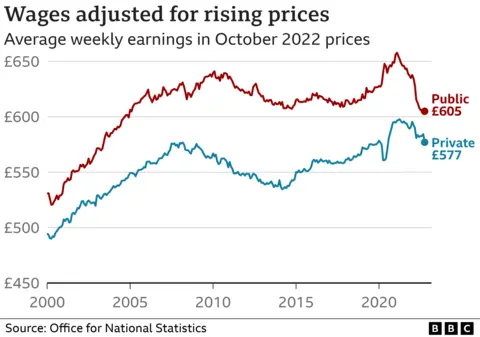What's the gap between public and private sector pay?
 PA Media
PA MediaA series of strikes has focused attention on the gap between pay in the public and private sectors.
Public-sector employees are generally those paid directly by the state such as teachers and members of the armed forces. All others work in the private sector.
The Office for National Statistics (ONS) says that private sector pay grew 6.9% between August and October 2022 while public sector pay grew 2.7%, and that this was among the largest differences ever seen between the two.
But both figures are still well below inflation - the rate at which prices are currently rising.

How much public-sector pay goes up usually depends on the recommendations of the Pay Review Bodies.
In several years since 2010, there have been public sector pay freezes or rises limited to 1%.
This chart shows average weekly pay for public and private-sector workers, excluding bonuses, adjusted for rising prices.

If you look at the total pay figures, which include bonuses, private sector pay has actually overtaken public sector pay.
That's because private sector workers are much more likely to receive bonuses than public sector workers and bonuses have been relatively high this year, particularly in finance and business services.
On the other hand, the figures do not reflect the fact that public sector workers tend to have considerably better pension provision than private sector workers.
Is it fair?
The Treasury said that freezing pay in 2020-21 had helped "to ensure fairness between the private and public sector".
Regular pay is still higher in the public sector, but whether that is fair is a tricky question.
As the Institute for Fiscal Studies (IFS) says, public-sector workers are more likely to be highly educated professionals who command higher wages in the labour market.
So the problem with comparing average earnings for the public and private sector is that highly educated professionals would be expected to be earning more.
The IFS also calculates the percentage gap between public and private sector pay if you take into account characteristics such as a worker's education and experience, which is the red line in the chart below.

Public-sector pay was frozen from 2011-13 and then capped at a 1% annual increase until 2018.
As a result, the difference between public and private-sector pay has narrowed since 2011, such that in 2019-20, there was no gap once you took into account their characteristics.
In 2020-21, the gap increased somewhat, indicating that the public sector workers on average had a better year than the private sector.
And we know that employees in the public sector worked hard during the pandemic, weren't generally furloughed and were less likely to lose their jobs than those in the private sector.
But in 2021-22, the difference became negative, meaning that private sector workers were being paid more on average if you adjusted for their characteristics.
Who's in the public sector?
It is not entirely straightforward working this out.
This has increasingly been the case as successive governments have paid private-sector companies to carry out lower-paid jobs such as cleaning, security or catering.
Since privatisation in 2013, Royal Mail workers have counted as private sector workers.
University lecturers also count as private sector workers, but that may be reviewed in 2023.
Rail workers employed by Network Rail were counted as part of the public sector from 2013, and those employed by most of the train operating companies were moved to the public sector in July 2020, after emergency measures were brought in during lockdown.
But many station cleaners, who have been outsourced to private companies, are counted as private sector workers, as are staff at some operators such as Hull Trains and Eurostar.
Recruitment problems?
The IFS found that after adjusting for workers' characteristics, the lower-paid half of public-sector employees are paid on average more than their private sector counterparts, while the higher paid half are paid less.
Higher paid public sector employees are more likely to be paid less than private sector workers with similar characteristics.
The IFS warned: "The continuing fall in public sector pay relative to the private sector poses recruitment and retention challenges for public services, and could threaten the government's ability to deliver on its public service objectives."
What about job security?
Of course, the attractiveness of a job is not just about the amount you are paid.
This analysis excludes pension provision, bonuses and overtime payments, which are not the same in the public and private sectors.
Also, one thing that the pandemic highlighted was the greater job security in the public sector, especially because those in the public sector were more likely to be classified as key workers.
And while unemployment is currently low, job security may become more of an issue as the country enters recession.



